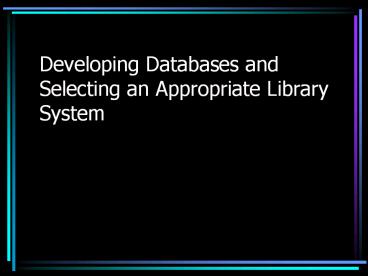Developing Databases and Selecting an Appropriate Library System - PowerPoint PPT Presentation
1 / 17
Title:
Developing Databases and Selecting an Appropriate Library System
Description:
... Resources. What is the MARC? MAchine Readable Cataloging ... 1960, Library of Congress. UNIMARC attempted to define only one code, especially in Europe ... – PowerPoint PPT presentation
Number of Views:33
Avg rating:3.0/5.0
Title: Developing Databases and Selecting an Appropriate Library System
1
Developing Databases and Selecting an Appropriate
Library System
2
What is a Database Management System (DMBS)?
- Database is an organized collection of related
data. - Computerized databases are those stored on
computer-readable media such as disks, diskettes,
tapes, and CD-ROMs. Computerization of data does
not ensure that they form a database. - A DBMS comprises programs to store, retrieve, and
otherwise manage a computerized database, as well
as to provide interfaces to application programs
and to nonprogramming users.
3
Why Use a Database Management System?
- Storing and retrieving data
- Managing metadata
- Limiting and controlling redundant data in
multiple systems - Supporting simultaneous data sharing
- Providing transaction atomicity
- Providing authorization and security services
- Enforcing business rules
- Increasing programmer productivity
4
Basic Data Concepts
5
Other Databases to Develop
- Continuing Resources
- Indexes, Abstracts
- Multimedia Resources (AV)
- Patron (Circulation Records)
- Electronic Resources
- Digital Resources
- Archives and Records
- Rest of the Librarys Resources
6
What is the MARC?
- MAchine Readable Cataloging
- Description and headings of all items in the
catalog created according to AACR - 1960, Library of Congress
- UNIMARC attempted to define only one code,
especially in Europe - USMARC in US, Australia, Philippines, etc.
7
Uses of the MARC Format
- The MARC format enables computers to sort and
file catalog data for purposes of - printing catalog data in a variety of formats
such as bibliographies - producing other products such as accession lists,
shelflists, book and spine labels - producing different types of catalogs such as the
OPAC - standardizing a machine-readable format for
bibliographic records for exchange of
cataloging data among libraries all over the
world
8
The MARC Record
- A MARC record is composed of three elements
- the record structure
- the content designation
- the data content of the record
- The record structure is derived from an
international standard for the exchange of
information on magnetic tape. - The content designation comprises the codes and
conventions defined by the MARC format. - The content of the data in the catalog record is
created using bibliographic standards like AACR2
and the LCSH.
9
Fields and Tags
- In a computer system, a record is a collection of
related fields. - In a MARC record, a field contains either coded
information (e.g., the date of entry into the
system) or bibliographic information (e.g.,
physical description or a subject heading). - Each field has an identifying label called a tag
and consists of 3 digits. - The Record Structure consists of 3 main
components - the leader
- the directory
- the variable fields
10
Variable Fields and Tags
0XX Variable control fields, identification
and classification numbers 1XX Main
entry 2XX Titles, edition, imprint 3XX Physical
description 4XX Series statements 5XX Notes 6XX
Subject added entries 7XX Added entries other
than subject, series 8XX Series added
entries 9XX Reserved for local use
11
USMARC Codes
020 ISBN 022 ISSN 050 LC Call Number
082 DD Call Number 100 Main Entry
Personal Name (NR) 110 Main Entry Corporate
Name (NR) 111 Main Entry Meeting Name
(NR) 130 Main Entry Uniform Title
(NR) 240 Added Entry Uniform Title
(NR) 245 Title Statement (NR) 246 Varying Form
of Title 250 Edition Statement
(NR) 254 Musical Presentation Statement (NR)
12
USMARC Codes
255 Cartographic Mathematical Data
256 Computer File Characteristics
(NR) 260 Publication, Distribution, Etc.
(Imprint) (NR) 300 Physical Description
310 Current Publication Frequency
(NR) 362 Dates of Publication and / or Volume
Designation 440 Series Statement / Added Entry
Title 490 Series Statement 500 General
Note 501 With Note 504 Bibliography, Etc.
Note 505 Formatted Contents Note
(NR) 508 Creation / Production Credits Note
(NR) 511 Participant or Performer Note
516 Type of Computer File or Data Note
13
USMARC Codes
520 Summary, Etc. Note 521 Target Audience
Note 538 System Details Note 546 Language
Note 600 Subject Added Entry Personal Name
610 Subject Added Entry Corporate Name
611 Subject Added Entry Meeting Name
650 Subject Added Entry Topical Term
651 Subject Added Entry Geographic Name
700 Added Entry Personal Name 710 Added
Entry Corporate Name 711 Added Entry
Meeting Name (NR) 730 Added Entry Uniform
Title 810 Series and Added Entry Corporate
Name 830 Series Added Entry Uniform Title
14
The Leader
00718nam//2200217/a/4500 001 ///93154367 003 DLC
005 19951019113246.0 008 940827s1993////at/ac//
//b////001/0/eng// 010 a///93154367 020 a18637
31695 (pbk.) c22.95 043 au-at--- 050 00 a
HQ1391.A8bS28 1993 082 00 a320.994082220 100
1 aSawer, Marian,d1946- 245 12 aA womans
place bwomen and politics in Australia
/cMarian Sawer and Marian Simms. 250 a2nd
ed.
15
The Leader
260 aSt. Leonards, N.S.W. bAllen
Unwin,c1993. 300 axiii, 345 p. bill.,
ports. c22 cm. 500 aPrevious ed. Sydney
Allen Unwin, 1984. 500 aIncludes
index. 504 aBibliography p.
309-328. 650 0 aWomen in politicszAustralia. 6
50 0 aWomen legislatorszAustralia. 700 1 aSimm
s, Marian.
16
Selecting an Appropriate System
17
A Presentation of the Different Integrated
Library Software
- Summarize the key benefits provided by the
product - Features of the software
- Services provided
- Online products and services
- Warranties
- Local system support (technical, etc.)
- Online support
- Pricing system (package, per module, add-ons,
- etc.)

